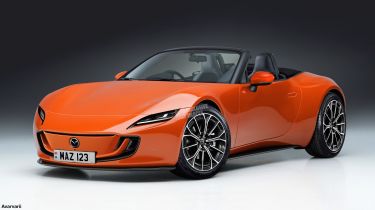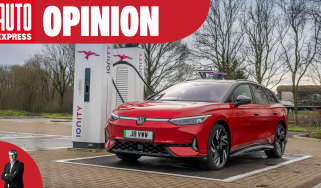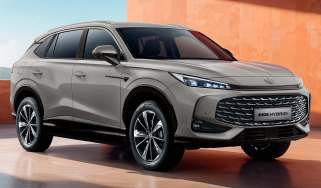Mazda MX-5 EV: iconic roadster set for electric power
The Mazda MX-5 is set to be offered as a pure EV for the first time, and our exclusive images preview how it could look
The current fourth generation Mazda MX-5 has been on sale for more than 10 years and, in the process, as become almost the antithesis of increasingly heavy electric sports cars by retaining its naturally aspirated four-cylinder engine.
However, it looks like things are about to change, because Auto Express has uncovered patents of a Mazda MX-5 with electric power – and our exclusive images show how it could look.
The patents, filed in the United States, show batteries located in the transmission tunnel section in what is clearly an MX-5-sized vehicle. This is at odds with the conventional ‘skateboard’ architecture seen on most pure-electric vehicles, which would make it difficult to create the low-slung driving position associated with Mazda’s roadster.
Positioning the batteries in the transmission tunnel is nothing new; the latest Lamborghini Revuelto does exactly this with its 3.8kWh unit. While the Lamborghini does this to supplement a plug-in hybrid system, Mazda’s drawings here are related to a pure-electric vehicle.
This rather innovative method to integrate the batteries has been employed to retain the traditional size, shape and weight distribution of the MX-5. Beyond the transmission tunnel, Mazda has also added batteries in front of the passenger seat and behind both seats; the latter is a feature that’ll we’ll see on the new Porsche Cayman EV.
The idea of needing a ‘transmission tunnel’ in the first place strongly suggests that the technology is based on a shared architecture between an ICE car, with a traditional gearbox mounting, and a pure-EV, although this isn’t mentioned in the patents.
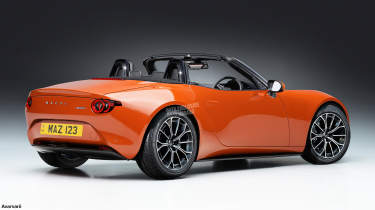
Mazda states in the filing that “since the battery is installed in the tunnel portion, the gravity center of the vehicle can be close to the center of the vehicle, thereby reducing the yaw moment of inertia more”.
The “yaw of inertia” Mazda is referring to here is essentially the vehicle’s directional change – lowering this helps make a car feel more nimble, a trait of the MX-5 since its launch thanks to the Japanese company’s renowned ‘Jinba-ittai’ (horse and rider as one) philosophy.
Information on the battery chemistry is slim, although Mazda does state it could be either conventional lithium-ion or even solid-state, with the firm already looking into developing the latter.
Battery and performance
There’s no word on the size of the battery pack in the MX-5 EV just yet, although given the focus on driving dynamics and keeping weight low, capacity will surely be kept to a minimum (although probably not as minuscule as the Mazda MX-30’s 35.5kWh unit, however).
The MX-5 has never really chased straight-line performance in its 35-year existence, with the latest model coming with a 181bhp 2.0-litre engine which can dispatch the 0-62mph sprint in 6.5 seconds. Judging from these early patents, it seems like this strategy will be employed for the electric model, too.
Instead of going with a dual-motor, all-wheel-drive set-up, there’s only a single electric motor. It’s positioned just behind the seats in the middle of the car, powering the rear wheels – just as you’d find in any production MX-5.

According to Mazda, the motor can also be placed behind either seat, which we’d assume is to accommodate left and right-hand drive markets. Because the filing was made to the US patent office, it would suggest that the technology is destined for the American market at the very least.
In the filing, Mazda also notes the importance of weight distribution with not only the battery, but the electric motor, too. “Since the motor is the heavy object, it greatly affects the yaw moment of inertia that it becomes necessary to properly decide an installation position of the motor.”
Mazda hasn’t suggested how much power the electric motor will make, although the firm does have a number to choose from. There’s the upcoming rear-wheel-drive 6e electric saloon, with a choice of 241bhp and 254bhp motors – both with 320Nm of torque. The MX-30 EV crossover, meanwhile, sports a less-powerful 143bhp and 271Nm motor.
Mazda MX-5 RF EV
Mazda mentions the patent filing is based on a car with a roof, which “may be a fixed type, a detachable type or a foldable type”, suggesting the MX-5’s convertible form will remain, possibly alongside a foldable hard-top version like the current MX-5 RF. The “fixed type” hints at a coupé version of the MX-5 – something that Mazda toyed with during development of the second-generation ‘NB’ MX-5.
Another key element of the battery and motor placement in the MX-5 EV seems to be added practicality. By positioning the motor behind the seats, there’s a front boot and a rear boot – possibly giving the electrified MX-5 more loading space than the current petrol-powered model, which has a maximum of merely 130 litres.
Design and rivals
As for the design, the patent drawings merely showcase the technological footprint, and nothing more. We’ve seen the Iconic SP concept hint at Mazda’s future sports car style – and while it may point towards an RX-7 return with rotary power, it’s possible the concept could influence the MX-5’s design too, which we’ve envisaged here with our exclusive images.

Throughout the MX-5’s long lifespan, it’s encountered a fair few rivals, including the Fiat Barchetta, BMW Z3, Honda Del Sol and arguably its closest competitor, the Toyota MR2, which is now set for a comeback.
There was an initial plan to launch an all-electric MR2, which was previewed by the FT-Se concept in late 2023, although it’s since been heavily suggested that the new model will come with a four-cylinder, turbocharged petrol engine.
That would leave the MX-5 EV in a field of its own. Porsche will bring out an all-electric Boxster before the end of the decade, and the MG Cyberster sits in the niche electric roadster segment already. However, the electric Mazda should undercut these by a significant margin, given the focus on value for money that its sub-£30k predecessors have always delivered.
Petrol power to retained alongside EV
The patent filing – which is simply titled “electric automobile” – doesn't confirm the MX-5 will be electric-only, however. Mazda set out its “multi-solution strategy” earlier this year with the aim to “provide customers with the right powertrain sources”, whether that’s internal combustion engines, hybrids or battery EVs.
As such, the replacement for the current ‘ND’-generation MX-5 will arrive later this decade as the ‘NE’ model with Mazda’s new internal-combustion Skyactiv-Z engine. The firm says the new powertrain will form the core of Mazda’s line-up “for small products in the electrification era”, while also meeting Euro 7 emissions standards. The engine has also been designed to achieve “high fuel economy” as well as deliver an “engaging driving performance”, according to Mazda.
Skyactiv-Z will be first seen on the next generation of Mazda’s big-selling CX-5 due in 2027 and will have the potential for plug-in hybrid or mild-hybrid assistance. Given how important low weight is to the MX-5’s driving dynamics, a mild-hybrid set-up would seem the most likely, and also help to promote the lifespan of the internal combustion-engined roadster.
This was backed up by Mazda’s new Chief Technical Officer Ryuichi Umeshita recently discussing a future internal-combustion engined MX-5 with a kerbweight target of under a tonne.
Mazda MX-5: through the years
Mazda MX-5 Mk1 (NA)
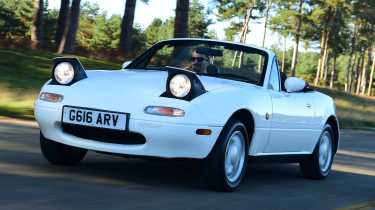
1989-1997
Back in 1984, Mazda solicited design teams from Japan and America for an affordable sports car with ideas ranging from a front-engined, front-wheel drive concept to a mid-engined rear-wheel drive layout - which matched the Mk1 Toyota MR2 which launch that year. The American team with its front-engined, rear-wheel drive proposal that got the MX-5 project rolling - a trait that continued throughout its life.
Mazda MX-5 Mk2 (NB)

1998-2005
The MX-5 Mk2 arrived in the late 90s and while it kept the same lightweight, rev-happy driving dynamics as the first one, it lost the characterful pop-up headlights. Both generations proved extremely popular and like the Mk1, the Mk2 had the option of 1.6-litre and 1.8-litre naturally-aspirated four-cylinder engines. Some markets also received a ‘Mazdaspeed’ variant - which was the only official turbocharged MX-5 from Mazda.
Mazda MX-5 Mk3 (NC)

2005-2015
With slightly podgier styling, there was a worry the third-generation car would lose the MX-5’s classic nimbleness. Those concerns were quickly put to rest because the weight-gain was minimal (35kg) and there was a new 2.0-litre engine to accompany the 1.8-litre unit, sending 158bhp to the rear wheels through a six-speed manual gearbox. A limited-slip differential also came standard on cars with the bigger engine.
Mazda MX-5 Mk4 (ND)
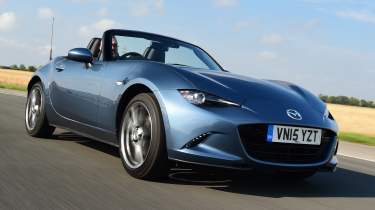
2015-present
Mazda really worked some magic for the current-generation MX-5. Not only was it lighter than the NC, but it took a few kilos off the NB too. With less weight to lug around, a new base-level 1.5-litre engine was introduced with 130bhp, though our pick of the ND MX-5 range is the post 2018 models with a 2.0-litre which featured a higher rev limit and more power at 181bhp.
Click here for our list of the best electric cars...
Used Mazda MX-5s for sale

2022 Mazda
MX-5
19,208 milesManualPetrol1.5L
Cash £17,489
2022 Mazda
MX-5
5,749 milesManualPetrol1.5L
Cash £19,699
2018 Mazda
MX-5
62,772 milesManualPetrol2.0L
Cash £11,450
2018 Mazda
MX-5
40,000 milesManualPetrol1.5L
Cash £11,700
2018 Mazda
MX-5
44,375 milesManualPetrol2.0L
Cash £12,495
2019 Mazda
MX-5
21,680 milesManualPetrol2.0L
Cash £18,596
2019 Mazda
MX-5
19,100 milesManualPetrol2.0L
Cash £17,990
2018 Mazda
MX-5
10,490 milesManualPetrol1.5L
Cash £14,199
2018 Mazda
MX-5
54,190 milesManualPetrol2.0L
Cash £14,495Find a car with the experts

